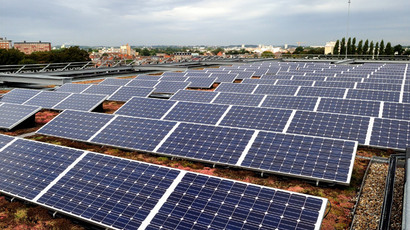Climate change reducing nutrition in staple foods - study

Increased levels of carbon dioxide emissions related to a warming planet will weaken nutrition levels in some of the world’s staple foods like corn and wheat, new research has found, impacting the poorest and most at risk of malnutrition.
Researchers at Harvard University found that predicted 2050-levels of CO2 in wheat, rice, corn, and soybeans significantly reduce the amount of iron, zinc, and protein in the crops.
"We found rising levels of CO2 are affecting human nutrition by reducing levels of very important nutrients in very important food crops," said Samuel Myers, author of the study and an environmental health expert at Harvard University, according to the Guardian. "From a health viewpoint, iron and zinc are hugely important."
Myers pointed out that 2 billion people around the world are already deficient in iron and zinc consumption, which causes most harm to babies and pregnant women.
"Fundamentally the concern is that there is already an enormous public health problem and rising CO2 in the atmosphere will exacerbate that problem further,” he said.
The research team compared nutrient levels in field crops grown in normal CO2 levels – around 380 to 390 parts per million at the time of the study – with crops grown in the level of CO2 expected in 2050, or 545 to 585 parts per million. Researchers analyzed 41 different strains grown in seven locations on three continents to take into account varying harvest conditions.
Wheat grown in the elevated CO2 levels had 9 percent less zinc, 5 percent less iron, and 6 percent less protein. The study’s rice had 3 percent less zinc, 5 percent less iron, and 8 percent less protein. Corn saw similar reduction in nutrients, while soybeans lost similar levels of zinc and iron, but did not see lower protein.
Why these crops dropped nutrient levels when exposed to heightened CO2 is yet unknown. Yet plant development expert Brian Thomas, a professor at the University of Warwick in the UK, told the Guardian that “the work is convincing and consistent with what we do know about the plant physiology."
Though wheat, rice, corn, and soybeans are relatively low in iron and zinc, the crops are a more crucial source for these nutrients than in regions where meat is eaten more often. Around 2.4 billion people get at least 60 percent of zinc and iron from staple crops, according to the Guardian.
Myers said eating more staple foods to meet the nutrient requirements is not an option for most people in the world, as food production must double by 2050 to satiate demand for rising populations.
"This is yet another example of the impact climate change is already having on people's ability to grow and access the nutritious food they need," said Hannah Stoddart, who leads Oxfam's food and climate policy efforts. "With 25 million more children under five at risk of malnutrition by 2050 because of climate change, action to cut emissions and support communities to adapt is crucial."
The researchers said breeding strains that are not as vulnerable to CO2 levels may be an option, based on what they found. Yet they added that these breeding efforts will not be a “panacea for many reasons including the affordability of improved seeds and the numerous criteria used by farmers in making planting decisions that include taste, tradition, marketability, growing requirements and yield."
Myers said rising CO2 levels may boost crop yields in some instances, but it’s not enough to ignore the warnings of studies like his.
"There may be a little positive effect, but the people who work in this area would not want to hang their hat on that in the face of the many other negative effects of climate change, including heatwaves, droughts and floods."
The research was first published on Wednesday in the journal Nature.
April was the first month for millions of years in which CO2 in the Earth’s atmosphere was over 400 pounds per million every day. Prior to the industrial revolution, which introduced large-scale fossil-fuel use, the CO2 level was 280 parts per million.
"It is very hard to predict all the challenges to human health resulting from climate change,” Myers said. “My guess is there will be many more surprises as we remake the environmental conditions on the planet. As a civilisation we are now living with 400 ppm for the first time: it's a new world."














